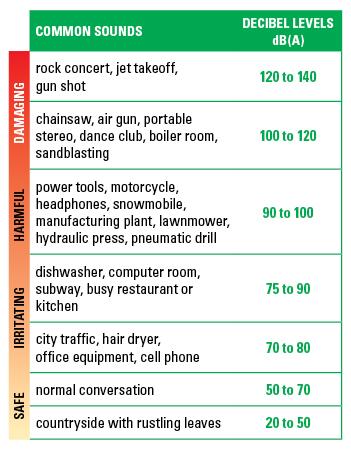What is noise and how does it cause hearing loss?
Noise is any unwanted sound that doesn’t happen in a natural environment. Noise can include sounds coming from machinery, highway traffic, and industrial, commercial and residential sources.
Noise is caused by pressure changes in the air created by vibrations, which are transferred to the ear by sound waves. The sound waves are then converted to electrical signals by delicate hair cells called cilia, found in the inner ear, or cochlea. These signals are transmitted to the brain and interpreted as sound.
Exposure to loud noise breaks down the cilia and large groups of the cells often get torn away. When the cilia become damaged they do not grow back and this can cause permanent hearing loss.
You can prevent noise-induced hearing loss by eliminating or reducing hazardous noise exposure in your workplace.
How do I know if my workplace has hazardous noise?
If you need to raise your voice to be heard, then the noise level is high enough to cause hearing loss. Hazardous noise is any sound that’s frequency (e.g., high pitch), intensity (loudness), and duration (length of time) can cause permanent hearing loss.
You can use a simple test to find out if your workplace has hazardous noise. For this basic check you do not need any special equipment, you just need to ask the following questions:
- Is the noise too loud?
- Is noise very noticeable or aggravating?
- Do you have to shout when talking to a person standing one metre away?
- Do you have to shout to be heard for at least part of the day?
- Do you have temporary hearing loss after working a shift that goes back to normal by the next day?
- Do you have ringing in the ears at the end of a work shift?
- Where is the noise coming from?
- Are vibrating or noisy tools being used during the course of a work day (e.g., power saws, blowers, hammers)?>
- Can certain machines be identified that cause noise (e.g., woodworking or forging machines)?
- Is the work environment noisy (e.g., demolition, foundries, mining)?
- Are there explosive sound sources, also called impact noise (e.g., metal hitting metal)?
- Are you being exposed to noise?
- Do you work in the area close to the identified noise sources?
These questions will usually give you enough information to determine whether you need to reduce noise exposure in the workplace.
This chart provides a range of common sources of noise to help you identify levels that might be dangerous. Sound levels are measured in decibels (dB). Exposure limits are generally measured on a dB(A) scale, which measures sound pressure levels (e.g., the loudness of sounds in air heard by the human ear).
For more information on how noise affects hearing, visit:
- the Canadian Centre for Occupational Health and Safety (CCOHS) website, and
- Noise-induced hearing loss health and safety resources for Ontario workplaces.
What are common characteristics and causes of hearing loss?
Work-related noise-induced hearing loss happens when a person has long-term exposure to hazardous noise in the workplace. It happens over time, is rarely painful, and takes years of continuous exposure to develop. Because of this, people often don’t realize they are being affected by noise-induced hearing loss until after the damage has become permanent. As a result, hearing loss is usually noticed later on, often after retirement.
The higher the noise level exposures, the sooner hearing loss develops. People can also experience greater hearing loss if high noise levels are combined with other workplace hazards, such as exposure to chemicals (e.g., styrene and toluene), heavy metals (e.g., mercury, lead and arsenic), vibration and extreme heat.
How do I recognize hearing loss?
Noise-induced hearing loss develops slowly over time and is hard to recognize in the early stages. The Canadian Hearing Society created a list of the common signs of hearing loss. They can include:
- straining to hear,
- speaking louder than necessary,
- constantly asking for words to be repeated,
- misunderstanding conversations, especially in noisy situations,
- favouring one ear,
- thinking that people are mumbling,
- turning the television or radio up louder than usual,
- having difficulty hearing on the telephone,
- withdrawing from social contact, and
- ringing or buzzing in one or both ears, also known as tinnitus.
Learn more
- Making a claim for noise-induced hearing loss
- Noise-induced hearing loss health and safety resources
- Glossary of hearing terms
- Program of Care for noise-induced hearing loss
Have questions?
- For more information, you can call us at 416-344-1000 (TTY: 1-800-387-0050) or 1-800-387-0750 with any questions, Monday to Friday, from 7:30 a.m. to 5 p.m.

